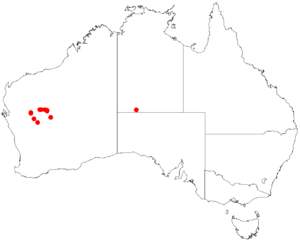Prostanthera ferricola facts for kids
Quick facts for kids Prostanthera ferricola |
|
|---|---|
| Conservation status | |
| Scientific classification | |
| Genus: |
Prostanthera
|
| Species: |
ferricola
|
 |
|
| Occurrence data from AVH | |
Prostanthera ferricola is a type of flowering plant found only in central Western Australia. It belongs to the Lamiaceae family, which includes mint plants. This shrub grows upright and has branches that spread out. Its leaves are shaped like eggs and smell nice when you crush them. The plant also has pretty mauve-purple flowers. These flowers grow in groups of four to twelve near the ends of the branches.
What it Looks Like
Prostanthera ferricola is a shrub that grows straight up. It usually reaches a height of about 0.3 to 1 meter (about 1 to 3 feet). Its branches are round and covered in tiny hairs and glands. These glands help the plant make its special scent.
The leaves of this plant are shaped like eggs. They are very fragrant when you crush them. Each leaf is about 5.5 to 10 millimeters long and 1.5 to 2.5 millimeters wide. They grow on a small stem called a petiole, which is about 0.5 to 1 millimeter long.
The flowers grow one by one in the spots where leaves join the stem. There are usually four to twelve flowers near the ends of the branches. Each flower sits on a small stalk called a pedicel, which is about 0.7 to 1.5 millimeters long.
The flower has parts called sepals that form a tube. This tube is about 2.5 to 3 millimeters long. It has two main parts, or lobes. The lower lobe is green or slightly purple and about 5 to 6 millimeters long. The upper lobe is purple-mauve and about 11 to 13 millimeters long.
The petals of the flower are mauve-purple. They are about 18 to 20 millimeters long and form a tube that is 15 to 18 millimeters long. This tube has two "lips." The lower lip has three sections. The middle section is egg-shaped, about 5 to 6 millimeters long and 9 to 10 millimeters wide. The side sections are about 5.5 to 6 millimeters long and 4 to 4.5 millimeters wide. The upper lip is broadly egg-shaped, about 6.5 to 7 millimeters long and 8 to 9 millimeters wide. It is deeply split into two parts. This plant usually flowers from July to September.
How it was Named
Prostanthera ferricola was first officially described in 1987. Two scientists, Barry Conn and Kelly Anne Shepherd, gave it its formal name. They wrote about it in a science journal called Nuytsia. They studied plant samples collected in 2006 from the Robinson Ranges.
Where it Grows
This special mintbush grows in central Western Australia. You can find it in areas called the Murchison and Gascoyne biogeographic regions. It prefers places with sparse Acacia aneura shrubland. This means it grows where there are not too many trees, mainly a type of wattle tree called Mulga.
Conservation Status
The Government of Western Australia's Department of Parks and Wildlife has a list of plants that need special attention. Prostanthera ferricola is on this list as "Priority Three." This means that scientists don't know a lot about this plant yet. It has only been found in a few places. However, it is not currently in immediate danger of disappearing.
Images for kids



